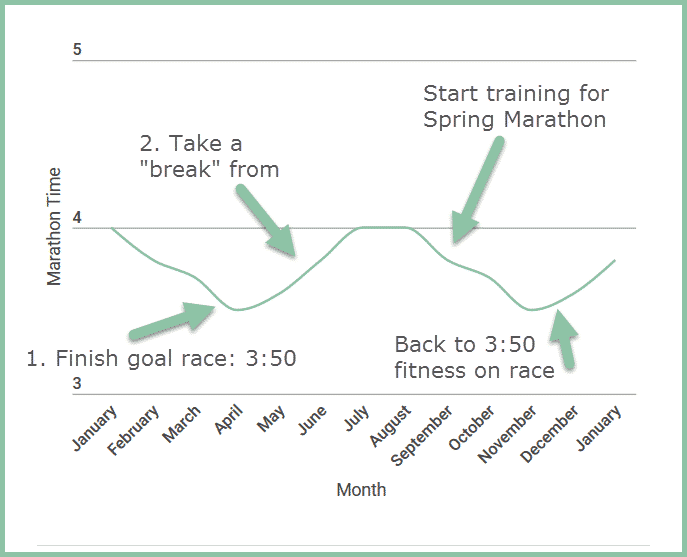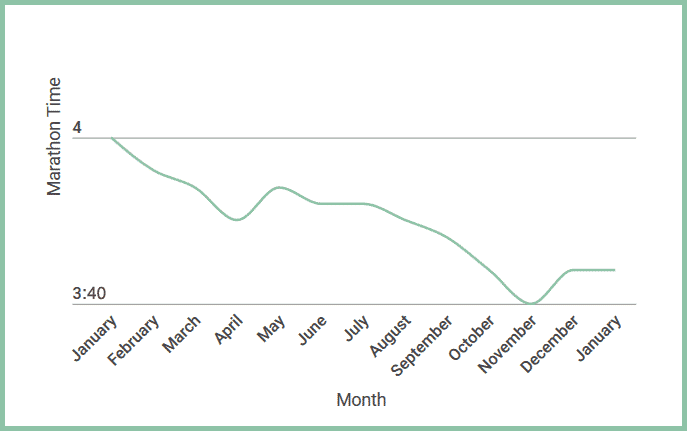There’s a common theme I’ve seen emerge the last couple of years with runners I’ve talked to.
Simply put, it’s neglecting the training in the months between goal races.
It could be “taking a break during the cold winter months” or “I don’t have another race on the calendar, so just taking it easy until I do”.
Unfortunately, this approach to training between goal races is what typically produces plateaus.
Now, that doesn’t mean you need to be 100% focused and on point with your training 365 days a year.
What it does mean is that often the training you do between your goal races is as important, if not more important, to your long-term progress than the 16 weeks leading up to your race.
If you’ve plateaued in your progression or you’ve ever wondered “what is my potential”, then this article will explain why and how to get yourself out.
Why training between races matters
When we look at how training progression works, we can easily see how plateaus occur when you don’t training effectively between goal races.
I think the easiest way to show this is with a graph.

This represents a year of training when you focus on just your two goal races each year.
As you can see, you start in January with a “fitness level” of 4 hours for the marathon. As your training progresses, you slowly get fitter until on race day you’re in 3:50 shape.
You’ve improved 10 minutes, not bad!
Then you take a small break. You don’t stop running completely, but you don’t have a direction for your training. Maybe you cross train a bit more, but overall you don’t focus on running.
As a result, your running fitness slowly decreases (I know technically it increases on this graph, but the Y axis is your “fitness level/time”. It doesn’t drastically drop and you don’t go back to zero.
Then August hits and you start getting serious about your November marathon. You pick up your 16 week plan and get to work.
The problem is, since you’re again beginning your training from the same starting fitness you did in January, the progress you make only gets you back to 3:50 fitness.
This cycle repeats from 16 week plan to 16 week plan. You’re stuck on a plateau.
Now, maybe you decide to train a little harder the next training cycle, hoping the increased volume and intensity will break you through this plateau.
But that’s not going to result in huge progresses in fitness. You’ll make marginal gains (if you don’t get hurt from training harder), but you’re not going to see the needle move much.
Now, let’s take a look at what your progress looks like when you training appropriately between goal races.

As you can see your progression from January to April is the same, so you finish with 3:50 fitness.
But, this athlete focuses on training in between the races.
Yes, your fitness takes a slight hit after the race as you recover properly. Plus, the progression isn’t as rapid as when you’re in an “all in” training mode like the 16 weeks before a goal race. You’re simply putting in smart, specific work (more on what that means below) – nothing crazy and not even at 100% intensity.
The result is that when you start training in August for your November race your fitness level is equal to, or maybe only slightly behind, that of what it was in November. Consequently, you make progress from August to November and finish in 3:40.
This is how you continually make long-term progress.
When does this not apply?
Like all discussions on training theory, I know I’ll hear the “well, I did basically nothing between my last two races and still improved”.
Good for you. Here’s the likely reason why.
Beginners and those whose previous race times are nowhere near their potential won’t hit this plateau for a couple of years.
This is because your starting fitness is so low (compared to your potential) that the progress you make in training is fairly dramatic. As a result, your regression between goal races doesn’t get you back to your initial starting state.
As you continue to get closer to your potential, you’ll eventually run into the plateau problem. Moreover, it means you’re not progressing as fast as you could be.
How to train between races
Okay, so it’s apparent that training between your races is important. The question really is “how do I train between races to maximize potential?”
The good news is that, if you don’t want to, you don’t have to be in full-bore training mode between races. You can still reduce the intensity, mileage and focus and make progress.
Here’s how…
You need to focus on your weaknesses.
That means if you’re a speed demon or have noticed that your shorter distance races are better, in comparison, than your longer races then you should concentrate on endurance based workouts, long runs, and aerobic development.
If you’re an aerobic monster, if you’ve run a few marathons in a row, or maybe you’re an older runner, then you should focus on improving your speed and mechanics.
The reason this works so well, even when your intensity is reduced, is that it allows all of your energy systems to balance out.
When you’re strong in a particular area or focus almost entirely on one distance, the primary energy systems used for that event are maximized in training. The energy systems you don’t use get little work and lag behind.
Unfortunately, at some point you will hit a point of diminishing returns where your stronger system can’t progress until you improve the lagging system.
A good way to visualize this concept is to think of a how window blinds work.
To raise a blind, you usually have two strings you need to pull. Each string controls one side of the blind.
If we imagine the blinds themselves to be your race performance and the strings to represent separate energy systems, you’ll find that you can only raise one side (pull one string) so far before you need to also begin raising the other string.
Therefore, by focusing your training correctly between races, you’re able to make progress long-term, even without training as hard.
How to implement this advice
It’s simple – take the training between goal races just as seriously as you do during the race build-up itself.
If you need some help with the specific workouts, a schedule, or some motivation to stay on track, consider one of our 6 week bootcamps.
These bootcamps are designed to help you structure your post-race recovery and improve your weaknesses so you can keep making long-term progress.
- Need to take a mental or physical break without losing all your hard-earned fitness?
- Want to work on strength or developing an injury-proof body but can never make time or don’t know what to do?
- Looking to lose weight or maybe work on your speed between races?
The simple-to-follow daily structure of our bootcamp programs is what has allowed us deliver results to hundreds of runners since they’ve launched.
Here’s what’s included in each bootcamp.
- A completely customized running plan for each day of the week with included off and cross training days as needed.
- Personalized strength training workouts based on your experience level and goals.
- Injury Prevention and treatment plans
- A private, small-group team of runners working through the same challenge.
- Our Coach Guided Bootcamps also include daily coaching feedback on your workouts as well as group coaching calls.

Our Current Bootcamps

So you’d like to add more strength work to your running plan? Or maybe you’d like to get started and finally get rid of your injuries for good?
This bootcamp will help you cut through the confusion and stay on track – to not only learn how to add strength work the right way and get healthy, but make sure you stay on track and get the results you want.
We’ll mold you into a stronger, faster, more resilient runner through a targeted strength training and injury prevention plan.
Learn more about the coach-guided strength bootcamp
Learn more about the self-guided strength bootcamp

Spice up your training and dust off the cobwebs on your speed (or finally get some if you’ve never had it!
Our 6 week bootcamp will incorporate some new and exciting workouts to your training get your legs moving fast. Plus, you’ll have strength work to prevent injuries and plyometric and drills to get your muscles firing explosively again!
Learn more about the speed bootcamp
Learn more about the self-guided speed bootcamp.

Whether you know a little extra weight held you back at your next race, you want to get ahead of the typical holiday weight gain, or losing a few extra pounds has been a long-time goal, this is the bootcamp for you.
Our daily running and strength plan combined with step-by-step nutrition guidance and accountability will finally get you on the path to a long-term healthy weight.
Learn more about the weight loss bootcamp

Do you have a goal of running a marathon or a half marathon, but just aren’t running enough mileage? Do you know your progress is limited by not being able to put in more miles?
Our mileage building bootcamp will give you a step-by-step plan to safely build your mileage while also adding the strength and injury-prevention work to ensure you stay healthy.
Learn more about the mileage bootcamp
Whether you’ve never really attempted to run before or you’ve tried a few times but just can’t stay consistent, keep getting inured, or just can’t progress the way you want, we’ll help you get there.
With daily mileages, exact paces, included strength and injury prevention work, plus access to our amazing team of coaches, we know we can help build you into a stronger runner!





